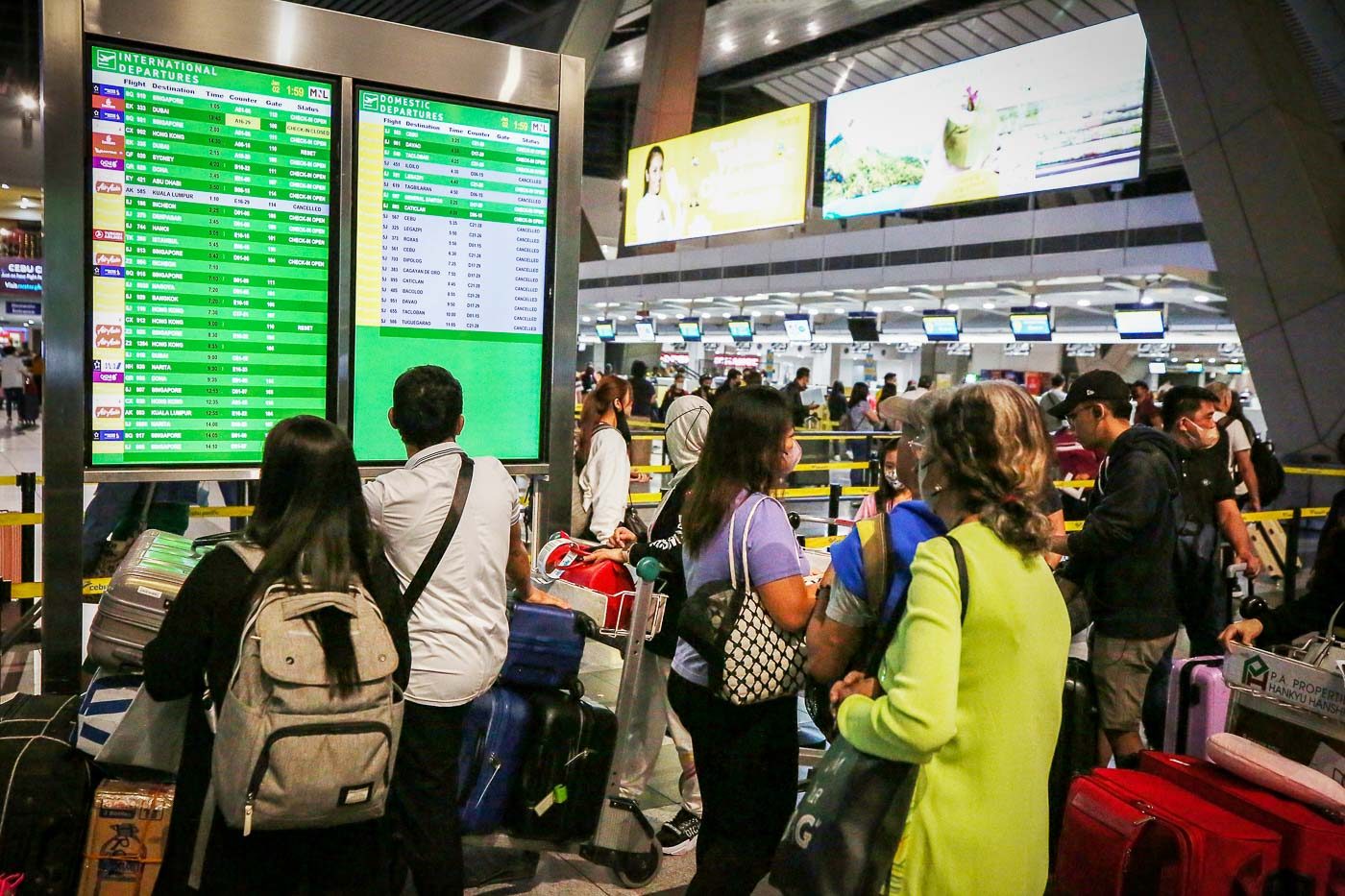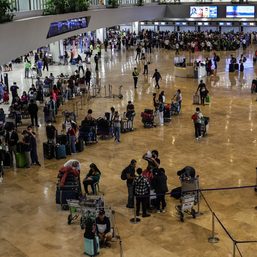SUMMARY
This is AI generated summarization, which may have errors. For context, always refer to the full article.

MANILA, Philippines – Filipinos and other travelers looking to end the holiday season on a high note were met with quite the opposite as hundreds of flights to and from Metro Manila were canceled on New Year’s Day.
The fiasco, which saw more than 65,000 passengers affected throughout the country, was due to “technical issues” that hounded the air traffic management system of the Civil Aviation Authority of the Philippines (CAAP).
The flight cancellations led to a domino effect, with many passengers forced to reschedule their flights, take other routes, or call off their travel plans altogether.
Government officials are scrambling to explain what led to the mess. Several questions, however, remain unanswered. Here’s what we know so far:
What happened?
In a press conference on Sunday, January 1, Transportation Secretary Jaime Bautista said there were two main problems that contributed to the New Year’s Day disruptions.
“The primary cause identified was a problem with the power supply and the degraded uninterrupted power supply, which had no link to the commercial power, and had to be connected to the other manually. The secondary problem was the power surge due to the power outage, which affected the equipment,” he said.
Take a look at the timeline:
- 9:49 am – A blower for the uninterrupted power supply (UPS) of the Communications, Navigation, and Surveillance/Air Traffic Management (CNS/ATM) system gives a warning before breaking down. The secondary UPS also fails to come online. This causes a power outage, shutting down communication, radio, radar, and internet access.
- 10 am to 12 pm – The Philippine Air Traffic Management Center (ATMC), which houses the system’s equipment for overseeing all flights within the country’s airspace, suspends operations.
- 12:19 pm – Power is restored after the system is manually connected to a commercial power source. But a subsequent power surge destroys crucial equipment called very small aperture terminals (VSATs), which handle satellite data for communication and navigation.
- 4 pm – By this time, a total of 282 flights are canceled, delayed, or diverted to other airports, affecting around 56,000 passengers at the Ninoy Aquino International Airport (NAIA).
- 4:18 pm – The ATMC partially resumes operations after the restoration of communications using the Tagaytay City radar.
- 4:55 pm – Philippine Airlines flight PR222 from Brisbane, Australia, becomes the first plane to land after the partial restoration.
- 5:33 pm – Cathay Pacific flight CX930 bound for Hong Kong becomes the first plane to take off from NAIA after the partial restoration.
- 5:45 pm – Normal operations resume as the CNS/ATM system goes back online, but equipment restoration continues.
- 7:30 pm – The number of canceled, delayed, and diverted flights reaches 361.
- 7:45 pm – Around 90% of radar surveillance is back online. NAIA has already accommodated several international arrivals and departures.
- 8 pm – A press conference is held on the technical issues. Bautista says the government is preparing for an urgent air traffic management system upgrade, which may cost more than P13 billion. The number of passengers affected by the fiasco is already more than 65,000.
On Monday, January 2, dozens more flights are canceled.
What is the current air traffic management system of the Philippines?
Bautista said the Philippines is at least 10 years behind Singapore when it comes to air traffic systems.
Singapore heavily invested in its air traffic management. The website of the Civil Aviation Authority of Singapore indicates that 200 million Singaporean dollars were set aside to fund research and development for this in anticipation of increased air traffic in Asia Pacific by 2030.
The current CNS/ATM system used in the Philippines was inaugurated in 2018. Back in 2017, the system was described as state-of-the-art and was said to put the country on the same level as developed countries.
In the New Year’s Day press conference, however, Bautista said the existing system was first introduced in 2010 but only implemented in the country in 2018.
“Parang midlife na itong system na ito na kailangan na talaga natin sigurong i-improve or i-modernize (This system is already midway through its life span, so perhaps we really need to improve or modernize it),” he said.
“[Maybe] we can still use it, but we need to upgrade this to a better system,” he added.
CAAP admitted that its CNS/ATM system was already behind when it became fully operational, given that a number of delays hounded the project from its conception until its launch.
Here’s a timeline of the CAAP’s system upgrade and what it looks like:
- 1990s – CAAP begins conceptualizing a new air traffic management system to replace its Eurocat system, which was implemented in 1996.
- November 2010 – The Department of Transportation and Communications (DOTC) awards the first work package to the Sumitomo-Thales joint venture. This includes the design and construction of the Air Traffic Management Center and ATM Automation System, and the final integration of the whole CNS/ATM system.
- April 2011 – The DOTC awards the second package to the joint venture, which involves the design and construction of a surveillance and communication system.
- May 2011 – The Commission on Audit (COA) suspends the advance payment of P58.92 million for the new CNS/ATM system.
- May 2013 – COA lifts the notice of disallowance against the DOTC’s advance payment.
- January 2015 – CAAP completes a P159.9-million upgrade of its air traffic management system while transitioning to the new CNS/ATM system.
- January 2017 – CAAP estimates that the CNS/ATM system is 92% complete and would be ready by June 2017.
- January 2018 – President Rodrigo Duterte inaugurates the CNS/ATM system and estimates that it would be fully operational within the year.
- July 2019 – Almost nine years after work began on the system, CAAP announces that the CNS/ATM system is finally operational and ready to begin “comprehensive operations.”
What can cause a UPS to fail in the first place?
According to CAAP Director General Manuel Tamayo, redundancies were in place to prevent a UPS from failing completely.
“Meron itong dalawang [uninterruptible power supplies]. It has two in existence by design. Ang design nito, just in case we have a power failure, or any of the UPS fails, fail-safe, aandar ‘yung isa,” he said in Sunday’s press conference.
(We have two uninterruptible power supplies. It has two in existence by design. It’s designed so that just in case we have a power failure, or any of the UPS fails, fail-safe, the other one would work.)
Based on an initial investigation, Tamayo said the UPS failed because one of its blowers “conked out.”
CAAP later attributed the failure to “a problem in the system’s electrical network, with its uninterruptible power supply, which is to be used as backup power supply, also failing.”
When asked whether poor maintenance had contributed to the failure of the UPS, Bautista gave assurances that the CNS/ATM system was well-maintained.
“We have a maintenance group that does the regular maintenance of the system. They are trained by Sumitomo and Thales who provided this system to us. We have a very good technical group that maintains this CNS/ATM,” the transportation chief said.
Tamayo said that while CAAP cannot fully guarantee that such a failure would not happen again, “well-qualified” technical personnel are constantly monitoring the system.
“Like anything mechanical, electrical, we cannot give you any assurances,” he said.
“Ang ginagawa natin (What we do), since it’s relatively old, more frequent monitoring is being done. In fact, this is done daily. Daily checks are being done by our technical people. Sa tagal nilang may experience dito (Given their lengthy experience), I think they’re well-qualified already.”
A CAAP representative also told Rappler that allegations that they failed to replace the UPS’ battery before its expiration date were untrue.
“This is not correct. We replaced the battery [in] 2020,” the representative said.
What will happen now?
CAAP is now investigating the main cause of the power supply issue. The probe falls under the responsibility of the Aerodrome and Air Navigation Safety Oversight Office, an office made up of technical personnel.
CAAP also said it already procured new equipment for the power supply, which are expected to arrive within 30 days.
Tamayo added that CAAP plans to spend millions of pesos to upgrade the aging CNS/ATM system in a bid to keep it functional.
“What we have been doing in CAAP, we budgeted P124 million to do some upgrades on the system, and that is due this year, 2023, for procurement. Hopefully, this will help extend the [system’s] life.”
Bautista said there is a need for a backup system situated in another location, but this would require not just a feasibility study but also “a huge amount of money.” A backup system, he said, would probably cost more than P13 billion.
The Senate, meanwhile, is set to conduct an investigation to determine who are responsible for the air traffic system fiasco and what to do to prevent a similar incident in the future.
Senator Grace Poe, chairperson of the Senate committee on public services, said the incident is a “national security concern,” adding that “thousands of lives depend on the efficiency and competence of CAAP.”
– Rappler.com
Add a comment
How does this make you feel?








There are no comments yet. Add your comment to start the conversation.